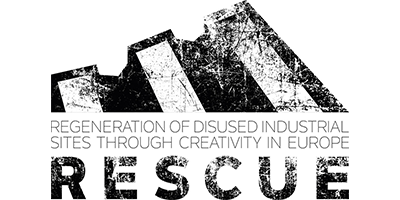RESCUE
REgeneration of disused Industrial Sites through Creativity in Europe
Programme and call
Creative Europe, CULTURE Sub-programme, Cultural cooperation projects – Call 2019
Active project
Short description
The project stems from the shared desire of the RESCUE consortium to promote, publicize and revive some pages of the history of work in disused industrial sites, huge structures and crucial places for local communities and entire regions, now abandoned and forgotten, in order to contribute to their revitalization through culture.
Because of its long industrial history and the changes in production patterns experienced over time, Europe is today the continent with the largest tangible and intangible industrial heritage in the world. Industrial heritage is a profoundly European theme and, although national histories may differ in detail, it remains one of the main common denominators of Europe. Industrial heritage includes both tangible assets – real estate and furniture – and intangible dimensions such as technical know-how, the organisation of work and workers, and the complex social and cultural heritage that has shaped the life of communities and brought about major organisational changes in entire societies and in the world at large.
The tangible and intangible components of industrial heritage are an essential part of the shared European identity as they reflect a rich history of interaction through the transfer of knowledge and skills, technology and processes across national borders. However, this heritage is highly vulnerable and has often been lost due to a lack of awareness, documentation, recognition or protection, but also due to changing economic trends, difficult environmental issues and its enormous size and complexity.
To prevent the memory and meaning of these sites from being lost, it is necessary to intervene with initiatives to recreate and reuse the spaces, opening them to the public and to entrepreneurial and socio-cultural activities.
Objectives
– provide an overview of the history of work linked to the former industrial sites located in the participating countries
– to involve young students and cultural companies in a programme of study, research and artistic interpretation of life and events in those places
– to preserve the memory and the significance of former industrial sites as founding elements in the creation of a shared European identity
– Activate a process of urban regeneration through performing arts
Actions
The main activities of the project consist of:
– School research workshops actively involving students to investigate the complex relationship between local industrial heritage, its history and the perception of local citizens in this regard
– Script development and production of works / shows in all partner countries
– A transnational residency to work on a co-production or workshop
– Analysis and tools to implement new strategies for urban regeneration of disused industrial sites through creativity
– Exchange of best practices related to the regeneration of disused industrial sites through creativity and sharing of an innovative management model for the enhancement and regeneration of disused industrial sites through art
– Public events for the dissemination of knowledge about the European history of the workforce and the conservation / enhancement of industrial heritage
– Communication, dissemination and audience development tools and actions
Results
– Revitalization of disused industrial sites through visual and performing arts;
– Improvement of artistic and professional skills;
– Increased and diversified public;
– Better knowledge of the history of places;
– Opening and visiting disused sites;
– Increased perception of the value of industrial heritage and its conservation/revitalisation;
– Reaching a wider and wider audience;
– Increased awareness of the importance and potential of industrial heritage among local communities
– Impact on immigrants in the cities involved and thus on their communities of origin
– Communication and dissemination of results across national borders of the partners involved
Lead partner
Municipality of Santo Stefano di Magra (IT)
Partnership
KulturTragWerk (DE)
Klanghaus (AT)
Association for Contemporary Art OX-P (SI)
Duration
The project has a duration of 24 months (1 October 2019 – 30 September 2021)24 months
Total budget
The European grant received is €198,000.00 out of a total budget of €330,000.00.
Funding body
European Commission – DG Culture




